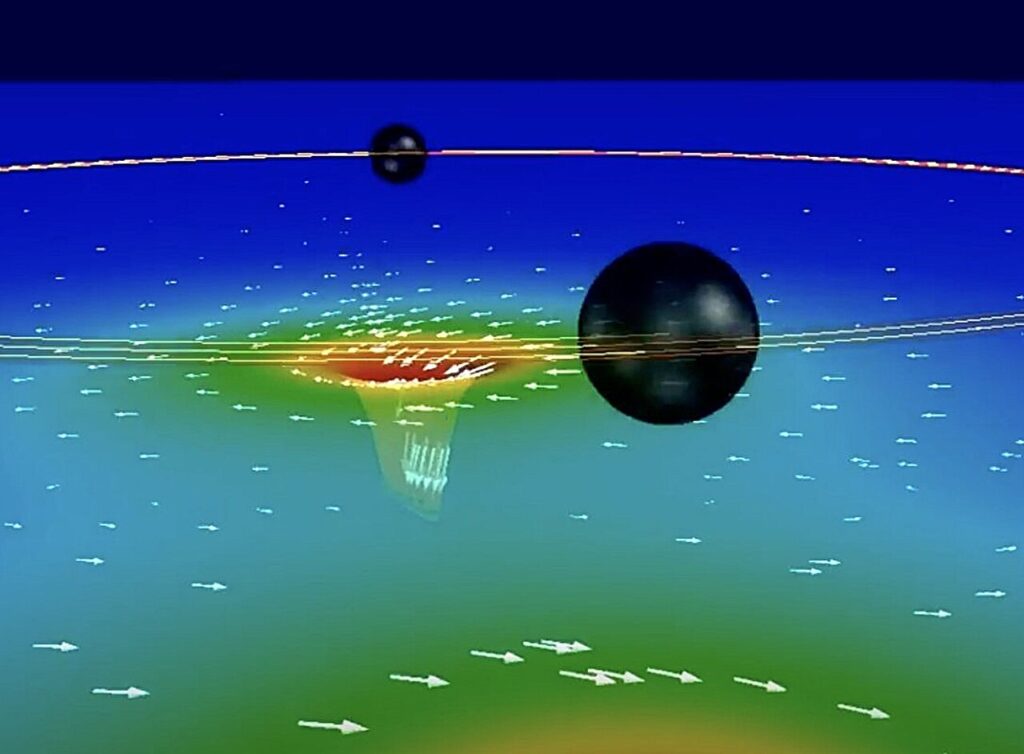
The Simulating eXtreme Spacetimes (SXS) collaboration has unveiled the third version of its extensive catalog of binary black hole simulations, marking a significant milestone in astrophysical research. This latest release, published in the journal Classical and Quantum Gravity, comes six years after the previous version and features nearly 4,000 detailed simulations, nearly doubling the size of its predecessor.
Since the Laser Interferometer Gravitational-wave Observatory (LIGO) first detected gravitational waves in 2015, the scientific community has been abuzz with the potential of these cosmic ripples in space-time. However, the groundwork for understanding these phenomena was laid decades earlier by the SXS collaboration, which has been calculating the expected gravitational waveforms resulting from celestial events like black hole mergers.
Understanding Gravitational Waves
Gravitational waves are generated by some of the universe’s most cataclysmic events, including the mergers of neutron stars and black holes. These waves propagate through space, and sensitive detectors like LIGO are designed to capture the minute perturbations they cause as they pass by Earth. The challenge, however, is not only in detection but also in predicting what these waves should look like before they are observed.
The SXS collaboration excels in this predictive aspect, solving complex equations derived from Einstein’s theory of general relativity to simulate how gravitational waves should behave. “You can take Einstein’s equations and write them in a form that’s described as hyperbolic, that suits analysis of wave-like phenomena,” explained Keefe Mitman, a NASA fellow at Cornell University.
“This means that if you give these equations some kind of initial data, there is a unique solution for how those data will evolve over time,” Mitman added. “And as we move to higher-resolution output, we can expect convergence: simulations that come closer and closer to the exact solution you would expect from Einstein’s equations.”
The Role of SXS in Gravitational Wave Research
Today, the collaboration between SXS and LIGO is a symbiotic relationship. Theoretical predictions from SXS guide LIGO’s observations, and in turn, LIGO’s findings refine the simulations. “We’re doing enough and LIGO is just catching up,” Mitman noted, highlighting the dynamic interplay between theory and observation.
This collaborative effort has transformed what once seemed an insurmountable challenge into a reality. In the 1970s and 1980s, theorizing events like black hole mergers using numerical relativity was considered more daunting than detecting gravitational waves themselves. Yet, within a few decades, gravitational-wave detection has become a cornerstone of modern astrophysics.
New Additions and Implications
The latest SXS catalog introduces a critical component previously absent: gravitational-wave memory. This phenomenon, predicted by general relativity, describes a permanent change in space-time caused by passing gravitational waves. “With gravitational waves, it’s a bit different,” Mitman explained. “After the gravitational wave has passed, that region of space does not go back to what it was before. It is permanently changed.”
“The catalog is widely used by the worldwide gravitational-wave community, with dozens of papers citing it every year,” stated Saul Teukolsky, the Robinson Professor of Theoretical Astrophysics. “For example, waveform models used to search for events in the LIGO data are calibrated against the highly accurate simulations in the catalog.”
The inclusion of gravitational-wave memory in simulations allows for more precise predictions of black hole mergers, enhancing the ability of scientists to test theoretical ideas about general relativity. This expanded catalog will undoubtedly serve as a vital resource for the global astrophysical community.
Looking Ahead
As gravitational-wave detectors like Virgo in Italy and KAGRA in Japan join LIGO in the quest to unravel the mysteries of the universe, the SXS catalog will continue to play a pivotal role. Future space-based interferometers, such as the Laser Interferometer Space Antenna (LISA) and the DECi-hertz Interferometer Gravitational wave Observatory (DECIGO), promise to expand the observational capabilities even further.
The SXS collaboration remains committed to theorizing the entire spectrum of possible black hole mergers, ensuring that their simulations keep pace with the ever-advancing field of gravitational-wave astronomy. By publishing their models online, they provide researchers worldwide with access to cutting-edge simulations and accompanying computer code, fostering a collaborative environment for scientific discovery.
As the boundaries of what is possible in astrophysics continue to expand, the SXS catalog stands as a testament to the power of theoretical prediction and its critical role in understanding the universe’s most enigmatic phenomena.






